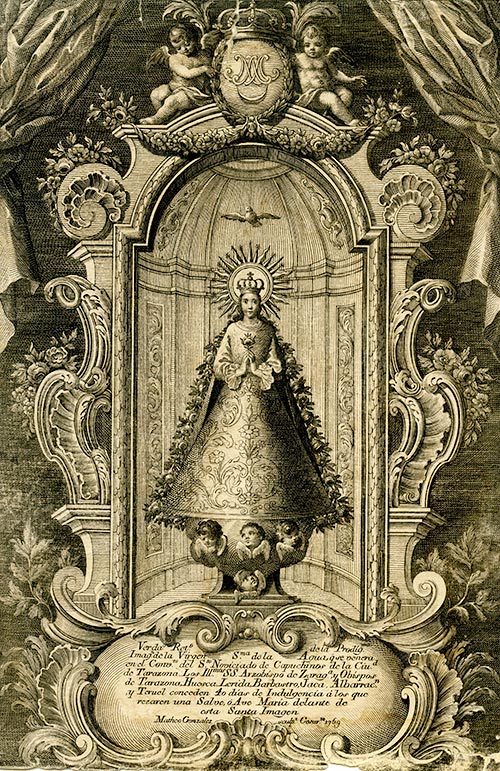An engraving of the missing image of the Virgen de la Agua de Tarazona, by Mateo González (1769)

The iconography of the Marian images which, in times past, enjoyed great popularity and devotion, inside and outside Spanish cloisters, has an obligatory reference point for its knowledge in the devotional prints. The latter bear witness to their iconographic evolution, since those icons that today seem static objects were not always presented in the same way. Tastes and mentalities often opted to alter the simple and majestic forms of the venerable medieval seated sculptures, turning them into vestments and pretending that they were upright. In the case of dress images, their appearance, adornment and headdress were in keeping with the tastes of the time, as well as the vision of the sacred held by their devotees. The prints, in many cases, not only tell us how the image appeared, generally behind its drapery, but also, on some occasions, reveal altarpieces and niches that have disappeared.
If the images have not been preserved or are unaccounted for, the engraving becomes even more important, a fortiori, if the print run was so short or the circulation so scarce that it makes some of them unique.
The latter is the case of an intaglio print of the Virgin of the Water, venerated in the convent of the Capuchins in Tarazona. Rebeca Carretero, in her monograph on the convent architecture of Tarazona, in her study of that complex, which has now disappeared, states that the iconography of Nuestra Señora de la Agua is unknown, adding that it must have been a dress image. He supports his argument with information about a donation in 1763 by the novice Friar Fidel de San Celoni (Rams y Rams), a native of the town of San Celoni in Barcelona. The religious offered all his clothes, weapons, jewellery and movable goods for the worship and adornment of the image. After the confiscation, the image was moved to the chapel of San Andrés in the cathedral and placed above the tabernacle. At present, its whereabouts are unknown.
Mateo Gonzalez's picture
The engraving, which we have been able to examine in a private collection, is cut on all sides, the cuts coinciding with the traces of the stamping. Its dimensions are 242 x mm. Compositionally, it adapts to the Rococo aesthetics, with a high semicircular niche, surrounded by mixtilinear moldings with abundant rockeries and garlands of roses and flowers. In the lower part, next to the signature of Mateo González and the date of the engraving, there is a long registration that shows the indulgences granted by different prelates for praying a Salve or a Hail Mary before the image. Its content reads: "Verda.º Ret.º de la Prodig.ma / Imag.n de la Virgen S.ma de la Agua q se venera / en el conv.to del S.to Noviciado de Capuchinos de la Ciu.d / de Tarazona. The Ill.mos SS. Archbishop of Zarag.a, and Bishops / of Tarazona, Huesca, Lerida, Barbastro, Jaca, Albarrac.n / and Teruel grant 40 days of Indulgence to those who / pray a Salve or Hail Mary before / this Holy Image / Matheo Gonzalez sculp.t Cesar.ta 1769".
The upper part of the composition is closed with a medallion with the "M" of Mary and the immaculist moon average , between two angels with palms. A rhetorical curtain gathered at the sides adds the theatricality typical of this subject of Baroque compositions. The image is clothed and presents a frontal pose, with her hands together in a prayerful attitude. She is crowned and assisted by the dove of the Paraclete. She wears a tunic in the shape of a large funnel and a cloak, barely visible from the front, surrounded by a garland of flowers.

Engraving of the Virgen de la Agua de los Capuchinos de Tarazona, by Mateo González, 1769. Private collection
As for the engraver, Mateo González, Count la Viñaza states that "he left very numerous engravings, mainly of images of the Virgin, in which he displayed a very clean, transparent and brilliant burin, and a very correct drawing: he only sinned in the mannerism of the heads, as they are all similar".
The artist and his ever-growing oeuvre have been the subject of a monograph by Luis Roy on Aragonese engraving in the 18th and 19th centuries. Mateo González Labrador was born in Daroca in 1740. He died in the Aragonese capital in 1807. We do not know data about his artistic training , although his exquisite handling of academic-rooted drawing suggests an influence of the great masters of the time, such as Manuel Salvador Carmona and Fernando Selma. His output includes portraits and religious prints, as well as numerous book illustrations. He worked for the Real Sociedad Económica Aragonesa and for the illustration of the work of the botanist Ignacio Jordán de Asso and other civil and ecclesiastical Aragonese institutions. The aforementioned Luis Roy states that he was "the most prolific Aragonese engraver, who supplied a good demand for prints in his homeland, and whose fame went beyond the limits of the old kingdom of Aragon".
The abundant work of Mateo González, always open to add to his Catalog, is enriched with the very delicate print of the Virgen de la Agua from the disappeared convent of Capuchinos de Tarazona.
To find out more
CARRETERO CALVO, R., Arte y arquitectura conventual en Tarazona en los siglos XVII y XVIII, Tarazona, Centro de programs of study Turiasonenses - Fundación Tarazona Monumental, 2012.
ROY SINUSÍA, L., El arte del grabado en Zaragoza durante los siglos XVIII y XIX, Zaragoza, Institución Fernando el Católico, 2006.
VIÑAZA, conde de la, Adiciones al diccionario histórico de los más ilustres profesores de bellas artes en España de don Juan Agustín Cean Bermúdez, (1894), vol. II, Madrid, Atlas, 1972.
